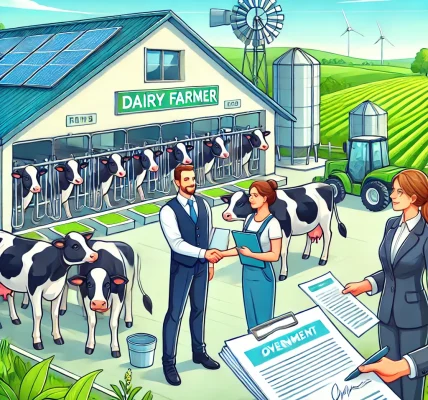Introduction
Small-scale farmers play a crucial role in ensuring food security and economic growth. However, financial constraints often limit their ability to invest in modern equipment, quality seeds, organic farming, and sustainable practices. To support these farmers, various government schemes and financial assistance programs provide loans, subsidies, and grants.
This blog explores the latest and most beneficial financial assistance programs for small-scale farmers. Whether you are a new farmer or an experienced cultivator, understanding these schemes can help you grow your agricultural business efficiently.
Importance of Financial Assistance for Small-Scale Farmers
Financial aid programs help small farmers in various ways:
- Improved Productivity: Access to credit enables farmers to buy better seeds, fertilizers, and machinery.
- Risk Reduction: Government-backed insurance schemes protect against unpredictable weather and crop losses.
- Sustainability: Grants and subsidies encourage eco-friendly farming techniques.
- Market Expansion: Support for processing, packaging, and storage helps farmers fetch better prices for their produce.
Top Financial Assistance Programs for Small-Scale Farmers
1. Pradhan Mantri Kisan Samman Nidhi (PM-KISAN)
Objective: This central government scheme provides direct income support to farmers.
Key Features:
- Financial aid of ₹6,000 per year, distributed in three installments.
- Direct benefit transfer to farmers’ bank accounts.
- Available to all landholding farmers across the country.
- Helps farmers meet their small agricultural expenses.
2. Kisan Credit Card (KCC) Scheme
Objective: To provide farmers with easy access to credit for agricultural needs.
Key Features:
- Short-term loans up to ₹3 lakh at a low-interest rate of 4% per annum.
- Flexible withdrawal and repayment options.
- Covers costs related to seeds, fertilizers, irrigation, and livestock.
- Includes an insurance cover of ₹50,000 for accidental death or disability.
3. Pradhan Mantri Fasal Bima Yojana (PMFBY)
Objective: To provide crop insurance against natural disasters and pest attacks.
Key Features:
- Coverage for losses due to drought, floods, pests, and other natural calamities.
- Low premium rates: 2% for Kharif crops, 1.5% for Rabi crops, and 5% for commercial crops.
- Compensation is directly transferred to the farmer’s bank account.
- Encourages farmers to take risks and invest in high-yielding crops.
4. Rashtriya Krishi Vikas Yojana (RKVY)
Objective: To provide funding for farm infrastructure, technology adoption, and skill development.
Key Features:
- Up to 50% subsidy for small-scale farmers for adopting advanced agricultural techniques.
- Financial support for setting up cold storage units, irrigation facilities, and processing units.
- Assistance for organic farming and integrated farming systems.
- Helps in value chain development for better market access.
5. National Agriculture Market (e-NAM) Scheme
Objective: To create a unified online trading platform for agricultural commodities.
Key Features:
- Eliminates middlemen, allowing farmers to sell directly to buyers.
- Helps small-scale farmers get better prices for their produce.
- Reduces price fluctuations through real-time demand-supply monitoring.
- Supports electronic payments for faster transactions.
6. Agriculture Infrastructure Fund (AIF)
Objective: To provide financial assistance for setting up farm-related infrastructure.
Key Features:
- Loan interest subvention of 3% per annum for projects like cold storage, warehouses, and primary processing centers.
- Maximum loan tenure of seven years.
- Encourages private investment in rural infrastructure.
- Available for individual farmers, FPOs, cooperatives, and agribusiness entrepreneurs.
7. Small Farmer Agribusiness Consortium (SFAC)
Objective: To promote agribusiness by supporting Farmer Producer Organizations (FPOs).
Key Features:
- Provides venture capital assistance for small farmers.
- Helps in formation and strengthening of FPOs.
- Offers marketing linkages for organic and high-value agricultural products.
- Enhances access to institutional credit through financial support.
8. Paramparagat Krishi Vikas Yojana (PKVY)
Objective: To encourage organic farming by providing financial assistance to farmers.
Key Features:
- Grants ₹50,000 per hectare for organic farming over three years.
- Assistance for composting units, biofertilizers, and natural pest control methods.
- Encourages farmers to reduce dependency on chemical fertilizers.
9. NABARD’s Rural Infrastructure Development Fund (RIDF)
Objective: To finance rural agricultural projects for small farmers.
Key Features:
- Long-term, low-interest loans for irrigation, roads, and rural markets.
- Focuses on farm mechanization, storage, and post-harvest management.
- Funds allocated through state governments for rural agricultural projects.
10. State-Specific Schemes
Many state governments provide additional financial assistance tailored to local farming needs. Some examples include:
- Maharashtra: Subsidies for drip irrigation systems.
- Punjab: Interest-free loans for small farmers.
- Tamil Nadu: Grants for setting up solar-powered irrigation pumps.
How to Apply for These Financial Assistance Programs?
Farmers can avail of these schemes by following these steps:
- Visit Official Government Websites: Use portals like PM-KISAN, e-NAM, or State Agriculture Department websites.
- Register Online: Fill in the required details and submit documents like land ownership proof and Aadhaar card.
- Apply Through Banks: For loan-related schemes like KCC, approach designated banks or cooperative societies.
- Consult Local Agricultural Offices: Get guidance from Krishi Vigyan Kendras (KVKs) or Panchayat-level agriculture officers.
- Track Application Status: Regularly check the progress of applications and respond to any queries from authorities.
Benefits of Availing Government Financial Assistance
- Reduces financial burden: Low-interest loans and subsidies ease the cost of farming.
- Encourages modernization: Funding for technology adoption improves productivity.
- Supports risk management: Crop insurance schemes minimize financial losses.
- Enhances market access: Direct selling platforms and agribusiness support help farmers get better prices.
Challenges and Solutions
Even with multiple financial aid programs, small-scale farmers often face difficulties such as:
- Lack of Awareness: Many farmers are unaware of available schemes. Solution: Government outreach programs and farmer training sessions.
- Complex Application Process: Some schemes have lengthy procedures. Solution: Simplification of digital applications and local assistance centers.
- Delayed Disbursements: Bureaucratic delays slow down fund release. Solution: Transparency measures and tracking mechanisms for faster processing.
Conclusion
Financial assistance programs for small-scale farmers play a vital role in promoting sustainable agriculture and rural development. By taking advantage of these schemes, farmers can improve productivity, manage risks effectively, and expand their businesses.
For regular updates on government schemes and financial aid, stay connected with our platform. If you need assistance with applications, consult local agricultural offices or government portals.




